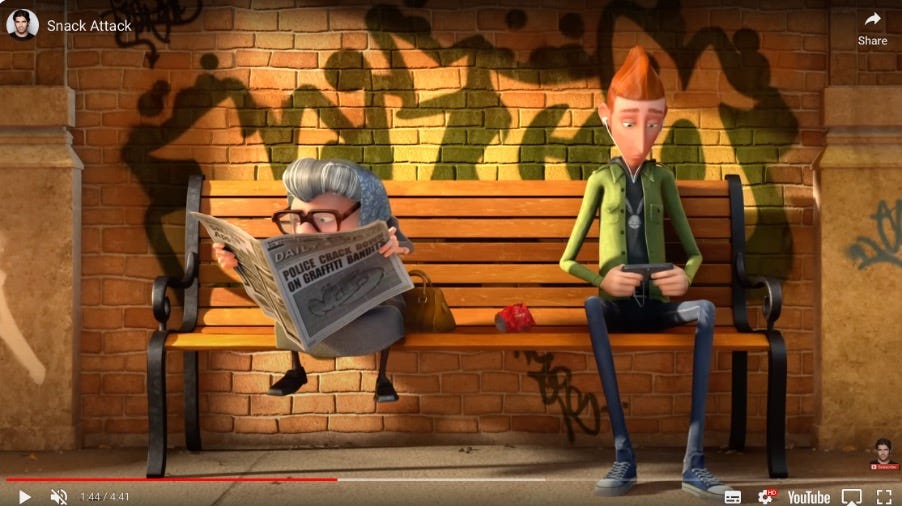Explaining MovieTalk
Using MovieTalk to provide compelling, comprehensible input to our students.
We languages teachers are always thinking of ways to introduce new language to our students for them to acquire. At this point in our lessons, it can easily become overwhelming for our students (we introduce too much too quickly) or just downright boring (I’m thinking back to the beginning of my career when I used powerpoint slides to introduce individual vocabulary items such as food). Some teachers, especially in the UK, find using substitution tables (or “sentences builders” à la EPI) useful to do this.
Over the past three weeks I’ve been fortunate to observe three teachers – Adriana Ramírez, Vicki Schrader, and Dr. Liam Printer – using a common CI technique called MovieTalk. MovieTalk was first developed by Dr Ashley Hastings, but has since evolved within the CI movement that is strong in North America (and growing in popularity in Europe). It can also be referred to as ClipChat or VideoChat. One of the great things about MovieTalk is that it can be done as a “zero-prep” activity, where input is just given aurally and on the whiteboard. Equally, you can extend it further by developing some written resources that can be used again for future lessons.
A clip from the animated film Snack Attack (available on YouTube).
MovieTalk in Practice
So how does MovieTalk work in practice? First, find a short film without sound that tells some kind of story. Animated films without audio work well for this and can be found easily online (if the film has audio, you can just turn this off). It’s best if the film isn’t longer than 3-4 minutes. There are many different ways of using MovieTalk, but I’ll now describe the sequence that Liam used in his Spanish class:
1. Aural input: Liam played the video to the class, stopping every couple of seconds to describe in the target language what was happening (you could also show screenshots on a Powerpoint). In order to make this more interactive and engaging for students, he asked lots of structured questions (Yes/No, either/or, question word questions. Remember: asking questions here serves to provide more input, as well as to check understanding.
2. Reading. After the intial aural/oral input phase, Liam presented a short summary of the story (around 150 words) on the screen. He asked the class to read the summary in silence.
3. Noticing: Liam asked questions (in L2) about specific vocabulary and form: “What is the word for X in Spanish?” “Is this present or past tense?” Noticing helps draw students’ attention to certain grammatical features we want them to notice and eventually acquire.
4. Ping-pong reading: Students read a longer version of the text and translate orally in pairs. Student A reads a sentence in L2 and student B translates into L1. They then swap roles. Every 3-4 minutes, Liam got the pairs to change. At this point, the pair started from the highest point in the text (i.e. Where the slower student left off. This ensures slower students aren’t left behind and gives valuable repetition to stronger students).
Liam decided to stop at this point, but he could have continued on with various written production activities such as answering comprehension questions and a written summary, à la Adriana Ramírez (see blog entry What is Embedded Reading in the Languages Class?)
Why is MovieTalk effective?
For me, there are a couple of reasons why MovieTalk is so effective.
1. Attention: students are intrigued to know what happens next and are therefore really engaged in the film. This holds their attention and allows the teacher to provide lots of interesting input. Because there is something interesting to talk about (i.e. the story of the film), students’s focus is on meaning and communication, rather than form (grammar).
2. Emotions: A good MovieTalk will evoke emotions and could be funny, sad or surprising. This emotional connection makes it easier to retain new language. It also means that pupils are less likely to worry about making errors as the “affective filter” is lowered (therefore enabling more language acquisition).
3. Retention: All vocabulary is introduced in context and related to the film the students are watching. Students aren’t being introduced to vocabulary items to them practise out of context.
4. Flexibility: The teacher can introduce or reinforce any vocabulary they like that will easily fit with the film. If the class are currently on a unit about physical description, the teacher can cover all this vocabulary by describing the various characters in the film. There’s a good mix of verbs, nouns and adjectives and means language is presented in collocations (“chunks”).
Finding MovieTalk videos
You could use one of the many CGI animations on YouTube in your lesson, or you could use a music video or short video from TikTok. There’s also a big community of CI teacher in North America who share videos, and you can find more of these here and here (many thanks to Tina Abour for sharing these links!)
If you’re interested in reading more about MovieTalk, check out the following links:
https://comprehensibleclassroom.com/how-to/movietalk/
http://teachingcomprehensibly.com/movietalk/
https://tprsquestionsandanswers.wordpress.com/2014/08/29/how-do-i-do-movietalk.




